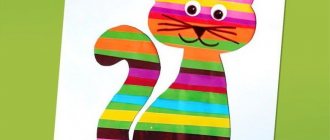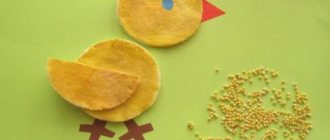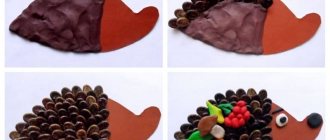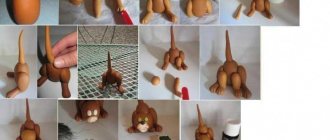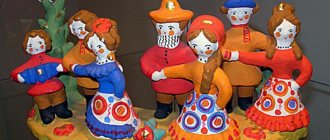Specific options for compositions on the topic “Water transport” in the senior group
Traditionally, in the second half of the school year (February), pupils of the senior group are offered an application on the theme “Steamboat”. A similar activity can be timed to coincide with February 23, and then a postcard with a picture of a steamship will become a gift for dad or grandfather.
In addition to the steamboat, you can offer preschoolers other variations on the theme of water transport. So the topic of the lesson can be designated as “Motor ship”, having previously explained to the children how these two types of transport differ (since the main role here is played not by external differences, but by the principle of operation of the engine).
Children can also use appliqué to create an image of a sailboat, submarine, or yacht (the teachers first explain in detail the characteristic features of each type of water transport).
In the older group, appliqué work on this topic can be done collectively, with each child performing some part of the composition. All elements are then combined against a common background. The topic of such a lesson can be designated as “Boats on the River”, “Seaport” or “Ships in the Roadstead”.
Cardboard ship: how to make it yourself
Children and parents are often asked to bring joint crafts to school on a given topic. It’s not difficult to come up with a cardboard craft on a marine theme. The ship can be made in one evening, taking an old equipment box.
Materials:
- Thick cardboard - old box
- Scissors
- Pencil
- Glue
- Scotch
- Colored paper
- Decor
Print or draw a template. Transfer it to cardboard
Cutting out parts from cardboard
Assembling the ship using glue and tape
Dilute the PVA glue with water, tear the paper into pieces and soak it in the glue. Glue the pieces to the ship blank
You can paint the ship and cover it with colored paper.
Also make a mast from a plastic tube or wooden skewer. Don't forget that every ship must have a flag. Make sails out of cardboard.
And if you recently bought a refrigerator or other large household appliance, then you can make a large ship out of cardboard to the delight of any boy.
Ship made of cardboard and paper
Cardboard is a very convenient material for crafts, and colored paper will help make the craft bright and attractive. In order for the work to turn out beautiful and neat, use good scissors that will not tear the cardboard, but will make a beautiful and even cut. If it is too early for a child to use sharp scissors, then parents can do it for them.
Toilet paper rolls are also actively used in crafts due to their shape.
Class notes
| Author's full name | Title of the abstract |
| Yanova O. | "Steamboat" Educational objectives: learn to compose an image of a steamship from parts, consolidate the ability to cut off the corners of a rectangle, cut out other parts of a steamship of different shapes, practice cutting out identical parts from paper folded like an accordion, improve the ability to harmoniously arrange an image on a sheet. Developmental tasks: enrich preschoolers’ knowledge on the topic “Water transport”, develop imagination, fine motor skills, and attention. Educational tasks: cultivate accuracy, patience, perseverance. Integration of educational areas: “Artistic creativity”, “Cognition”, “Communication”, “Socialization”, “Health”. Demo material: pictures depicting a steamship, a ship's captain. Handout: sheets of blue paper according to the number of children, white and brown paper rectangles, small pictures with the image of the captain, glue, scissors, oilcloths, glue brushes, rags. Progress of the lesson: The lesson begins with a riddle about the postman. The teacher reports that the postman brought two envelopes to the group. The first contains a riddle about the captain:
There are also paper parts for appliqué: white and brown stripes, one long and wide, the other narrower and shorter. The captain wants to teach the children how to make a steamboat out of two rectangles. Physical school is carried out:
The teacher repeats the rules for handling scissors with the children. The teacher explains the sequence of making the steamer. First, you need to cut a trapezoid from a large rectangle by bending it in half and cutting off the corners. Then a pipe consisting of a square and a rectangle is cut out. Round portholes are cut out of a square folded in four. Independent activity of children. Analysis of works. |
| Gurina O.A. | "Ship" The teacher informs the preschoolers that the country will soon celebrate a holiday - Defender of the Fatherland Day. There is a conversation about dads who were once soldiers because they served in the Army. It is discussed what qualities a soldier should have. Physical school is carried out:
The teacher talks with the children about what they can give to dad and leads them to the conclusion that the best gift is the one made with their own hands. The teacher offers to make dads a postcard with a picture of a boat and reads a poem to the children:
Children share their impressions after listening to the poem. The finger game “Brave Captain” is being played:
The teacher explains the stages of making the craft. Moreover, the sun and waves are cut out with curly scissors. The ship has a sail, which is located at an acute angle upwards. The sailboat is accompanied by faithful friends - white gulls. Independent activity of preschoolers. At the end of the lesson, the children dance to the song “Blue Water.” |
| Kazunina Yu.P. | "Submarine at Sea" The lesson begins with a riddle about a submarine:
The teacher shows the children a presentation about this type of water transport. The children learn that all submarines are dark in color and have a distinctive shape. The teacher shows the children a sample of the applique that she made in advance. A sheet of paper is tinted with wax crayons, and the sky is multi-colored. This happens when the sun drops below the horizon. The submarine is glued in the middle of the sheet because it is the main element of the composition. The sun is a yellow circle, and the clouds are designed in a broken way from a white rectangle. Seagulls complement the seascape. Physical education is conducted to the music:
Independent work of children. Exhibition of finished compositions, discussion of the features of the works, highlighting the most spectacular and neat ones. |
| Ushmaeva M. | "The boat is sailing, sailing..." (application with drawing elements) The teacher reads the English song “The boat is sailing, sailing”:
The teacher informs the children that they have arrived on a fabulous uninhabited island and invites them to play the game “The Sea Is Worried Once.” Next, preschoolers are invited to a magnetic board, where reproductions and pictures of ships are presented. The children discuss what they saw. The teacher reads an excerpt from “The Tale of Tsar Saltan...” by A.S. Pushkin:
Children are invited to conduct an experiment - blow on a paper napkin and show how “the wind blows across the sea.” Then the teacher informs the children that they will make an applique of a sailboat today. The structure of a sailing ship is clarified, and methods for depicting volumetric sails are discussed. For preschoolers who can quickly complete the task, the teacher suggests creating relief waves using napkins. Physical education “Seagulls are circling above the waves” is being held:
Independent activity of preschoolers. Summing up the lesson. |
Applique steamer and sailing boat on the water.
Option 2
Here are two simple, short diagrams of a paper boat; you can use them to make two different boats. You will also need colored paper
Below are several options for paper boats of varying complexity; choose the one that suits you. I hope you enjoyed this master class on making a boat. I wish you success in your work!
How to make a ship out of shells with your own hands
Did you bring a lot of shells from the sea? They can be used and beautifully decorated by making a boat out of shells. Resorts sell ready-made souvenirs in the form of ships made of shells, but it is much nicer to put on a shelf a craft made by your child.
Materials:
- Big shell
- Small shells
- Super glue
- Braid
Come up with a diagram of your ship.
Place several shells in a row with a toothpick. It will look more beautiful if you arrange the shells according to size - wider at the bottom and smaller at the top.
Lubricate a toothpick with glue and attach the shells. Let's leave it to dry.
Let's attach these sails to a large shell. The base of the toothpick should be generously coated with glue.
We use a chain or gold braid. We wrap it around the mast. To ensure that the boat stands level, you can glue a large shell onto a piece of wood or a flat stone.
Simple applications of geometric shapes for little ones
Crafts, souvenirs and mosaic applications of geometric shapes are ways to engage your child in useful practice. Participation in joint activities is a guarantee of high aesthetics of work, where children perform the feasible part of the task. This develops imagination and imaginative thinking.
Important! When teaching small children to work, pay special attention to the safety of the tool.
- Scissors don't have to be dangerous. There are special children's scissors for working with paper. They are distinguished by rounded ends and plastic tips that cover the outer part of the instrument. In any office supply store, the seller will show you what you need. Before work, you need to make sure that the blade is sharp enough to work with paper, the screw provides freedom, and the format is convenient for children's hands.
- Colored paper is the basis of geometric appliqué. It is sold in A-4 format packages. Additionally, white office paper, napkins, a “reaper” and foil on a paper backing are used. Colored cardboard is suitable as a background. Occasionally, scraps of wrapping paper and other pliable materials can be used for the work of children 6–7 years old.
- Glue is the main way to connect applique fragments into a single image. The composition and packaging are selected according to the age characteristics of the children. A glue stick is more suitable for kids; older children need to learn to work with a brush or the narrow spout of a PVA bottle.
Note! Any adhesive quickly dries or polymerizes. Before use, check the adhesiveness. At home, if you don’t have silicate glue or PVA, you can make a paste from flour or dilute a little dry mixture for wallpaper.
A carefully executed “fox” or “cat” appliqué made from geometric shapes requires patience from adults, and perseverance and consistency from children.
If children are interested and provided with everything they need, including safe tools, completing the task will be a lot of fun.
Photo gallery of finished works - ideas for teachers
The application is combined with gouache painting and plasticineography
The applique is combined with drawing with wax crayons. A combination of applique (boats made using origami) and drawing (the sky and reeds)
Original waves are made from strips using the breaking technique
Simple origami, which is complemented by drawing
Application in the form of a postcard for dad with original waves (the teacher prepares them)
A broken applique with filling in a drawn template. Children fill in the drawn outline with pieces of paper; sails made from bright fragments look colorful
Applique classes should practice and improve the visual skills of preschoolers, as well as expand their horizons and knowledge about the shape of surrounding objects. Thus, the theme of a boat or a boat sailing along a river can be played out in a very interesting way, using the right motivation and using unusual materials.
DIY foam ship for children
Do not rush to throw away foam plastic after purchasing household appliances, especially if you have children. It can be useful for making a quick boat.
Materials:
- Styrofoam pieces
- Toothpicks
- Knife
- A thread
- Film for decoration
- Colored paper
Using a knife, cut out the shape of a boat - two rectangles of different sizes. A large rectangle needs to have a sharp nose.
Using glue or a toothpick, connect both parts
All that remains is to decorate the boat. In this matter, you can give your child room for creativity.
Cut out flags from paper and glue the flag onto the mast.
You can add a second toothpick to the ship and tie them together with rope or thread. We'll insert another toothpick at the back of the deck. The places where the thread is attached can be lubricated with glue.
The outermost toothpicks need to be shortened.
We will hang small flags folded in half on the thread.
Another option for a ship's mast made of foam.
Let's make a cross from two toothpicks and wrap it with thread. Let's break off the ends.
The sail can be made from a tree leaf or fabric.
More complex foam ship designs will require more time.
